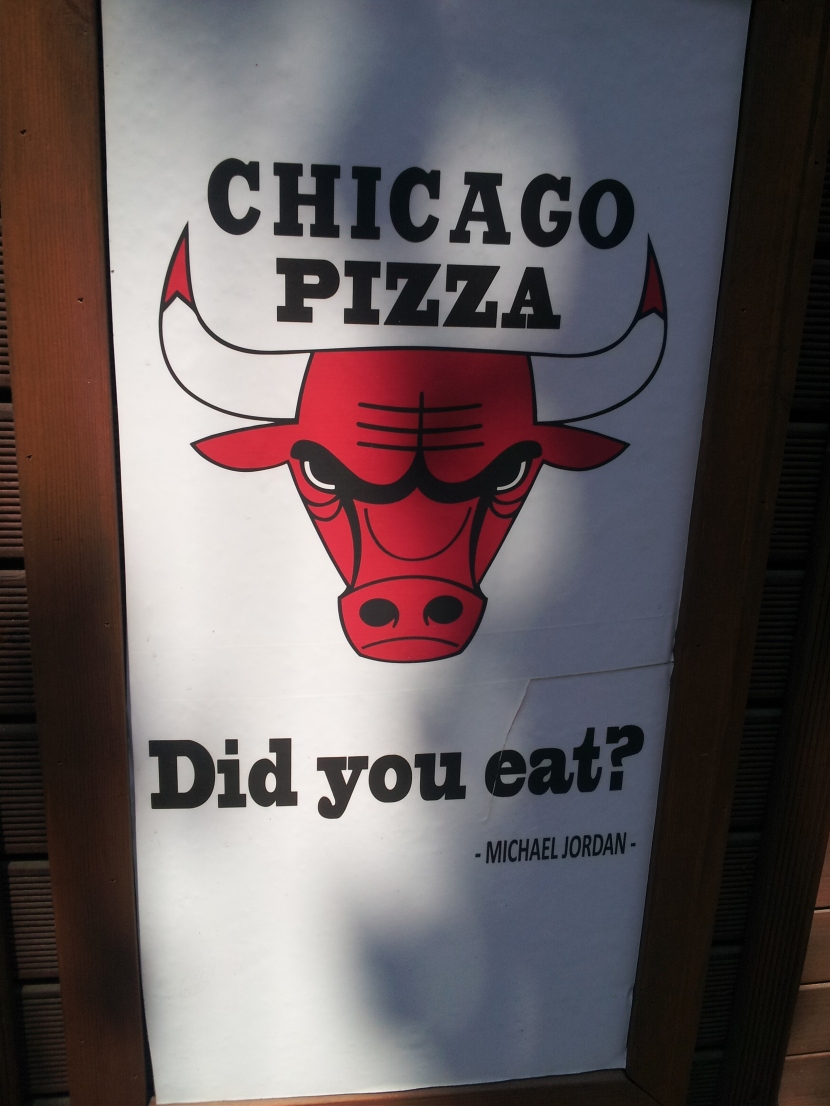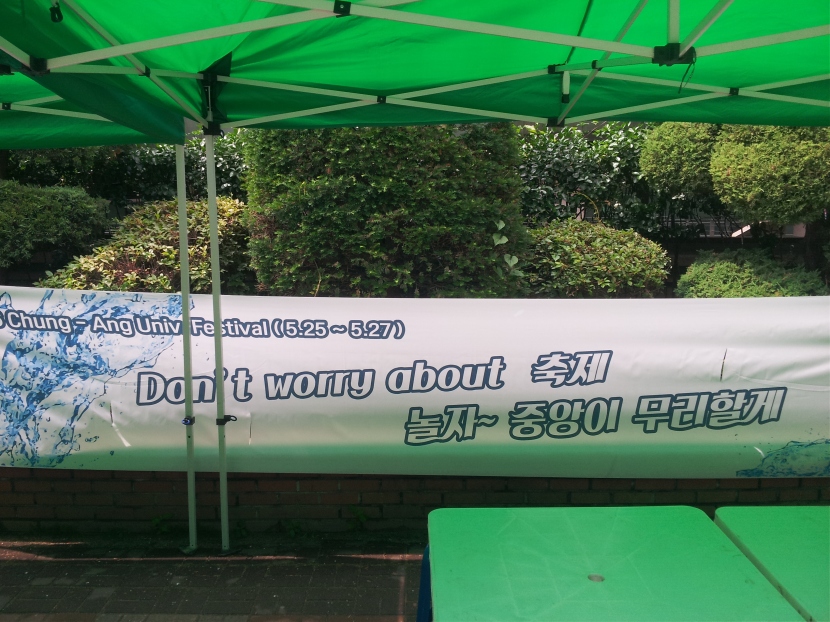Get your Linguistic Landscape on
I recently participated in an interesting course from iTDi. The course was called Creating ELT Materials and was led by Katherine Bilsborough. I learned a lot in the course and decided to share some of the material I used for one of the assignments.
The assignment was to create learning materials based on authentic material. I pored over the Authentic* materials that may or may not be useful for class page on this blog and decided to try something new. I had a bunch of pictures of signs from around Seoul on my phone and thought I could cook up something interesting using these signs.
Thus far, with my future interpreter/translator students I have not done too much with signs except for occasionally asking students about the Korean in a particular interesting looking (well, to me at least) sign. I think there is a lot of room to exploit English and mixed English signs in an EFL country. My friend Michael Chesnut’s narrative article on three Korean undergraduate students’ experiences conducting a linguistic landscape research project can be found here and might offer some food for thought.
Another potentially useful resource is the Map of the Urban Linguistic Landscape blog which has a variety of pictures as well as ideas for using them. This Storify of the #KELTchat on Linguistic Landscapes also has a lot of ideas for using linguistic landscapes with classes and the preview for that KELTchat chat also includes some nice links including a post from Scott Thornbury. If readers would like to share other useful and related links in the comments I’d be happy to paste them here in the body of the post.
In order to use the signs in class I thought I’d simply create a slideshow of the pictures and have students look at the pictures in turn and discuss them with a partner. I’d also offer some suggested questions which would be something like the following:
- Have you ever seen this sign before? If so, where?
- Why do you think Mike chose this picture?
- Where might we find this image? What is the purpose of this sign?
- How can we say the English part in Korean? How can we say the Korean part in English?
- Are there any interesting aspects of this sign?
- Do you think the sign conveys what is intended?
- Is there anything you’d change on this sign? Why
- What do you think about the choices to use English in this sign?
- What questions do you have for Mike or our classmates?
One thing I wanted to avoid in this lesson was choosing a bunch of pictures that showed bad English all over town. I wanted to avoid the Engrish.com style which I figured could be demotivating (though also potentially valuable as a way of identifying errors). I wanted to focus on things I thought were interesting rather than simply wrong. I think there is enough worry about getting signs wrong in Korea as witnessed by this recent article in The Korea Times, “Authorities fry [SIC!] hard to fix Korean menus lost in translation.” So, sometimes in the pictures below there is something that probably *should be changed but not always. There is always something I found interesting. Please enjoy the pictures! I will share some thoughts and a brief explanation of each picture at the bottom of this post. All shots were taken on my Samsung Note II and were taken with #nofilter.

1) Don’t get your freak on, though.

2) So repurous. Very temptation.

3) Especially dangerous to say in Korea, perhaps

4) Not his most famous quotation.

5) Presumably about the Greek (well, actually Egyptian originally) goddess.

6) Good ol’ Uncle Beard.

7) Cool example of mixing languages in the same word.

8) All the cool guys avoid peeing on the floor.

9) Delicious.

10) Party without worries.
My notes and explanations:
(If I missed anything or got anything wrong please let me know. I’d also be happy to explain more, or better yet ask a student to do so, if the brief explanation is not enough.)
- I mostly chose this because I thought the phrase “get your __ on” was interesting. I wasn’t sure if most of my students would know it but there it was on an ad for the whole student population to see. I was also interesting in hearing what sort of feeling this expression might give readers. Does it seem hip and cool or forced and strange? Does it seem too casual? Does it matter?
- I know I said I didn’t want to focus too much on errors but this was too interesting. It is actually just a typo. The only hits on Google for repurous seemed to be Chinese and Korean misquotes of the following:The instinct of the coffee is temptation.
Strong aroma is sweeter than wine, soft taste is more rapturous than kiss.
Black as the devil, hot as hell, pure as an angel, sweet as love.
– Charles–Maurice de Talleyrand–Périgord (1754 – 1838)
I am not sure if there is much learning from this except that we need to be careful and that spellcheck can be a good friend. - Many of my students this year were surprised to note the difference between “I love dog” and “I love dogs.” This picture is a good way to introduce the concept.
- The main reason I chose this picture is because of the importance of the question “Did you eat?” in Korean culture and how it doesn’t always match to what “native speakers” would expect to hear. There might be more on this question in an upcoming post.
- My guess is if this salon were in the US they would have changed their name. But it is not and they didn’t and the name jumped out at me. Maybe it’s not all that interesting. Moving on.
- The Korean word 아저씨 (ajeossi) is something like “older guy” but here they called it Uncle (which is not so far off). And the guy (the owner of the restaurant) has a beard so he became “Beard Uncle.” Maybe “bearded uncle” would have worked. I’d probably go with “The bearded guy ” but I don’t know. I’d love to hear how students would translate it.
- There are some interesting things happening here including using two scripts within one word.
I’m reading this as a pun on a Korean folk tale (Kongji and Patji) and a pun on
Bean 콩 (pronounced “kong”)
Red bean 팥 (pronounced “pat”)
Which makes Kong-G (kongji) and Pat-G (patji/patzzi).
Maybe my students won’t think it as clever as I do and maybe they will not be as impressed with themselves for figuring it out but I felt compelled to share it. - I love this image so much and actually used it in a presentation recently. The basic idea is that Chung-Ang is the name of my uni and chung-ang in Korean (and Chinese characters) means “middle.” This image is found in the male restrooms, exhorting viewers to be “Chung-Ang people” and aim for the center.
- Very punny.
- It says something like “Don’t worry about the school festival (which is like “Spring Weekend” in some US colleges). Chung-Ang University will pay for you.” The English in the first line caught my eye, especially because the sign is for the whole student population. I had to wonder what was behind the choice to use English here in this way.
Updates:
Sandy Millin shared some great links/sets from #ELTpics in the comments and here they are:
Linguistic Landscapes
Signs:
Weird, wacky English
Kudos for this. I’ve used stuff from the linguistic landscape before and it went well. Students above a certain level tend to revel in the ‘bad’ Engrish-stuff. Getting a communicative priority rather than a grammar-rule-knowledge-based priority going on can be hard but linguistic landscape stuff provides a real-world example. Ace post, Mike. Cheers.
Hello Marc! Thanks for the response. I am happy you liked it.
I think you make a good point about students easily placing a priority on grammar or corrections (which is of course fine and reasonable) so I think it can be hard to step away from that. This is sort of the risk of choosing some examples with questionable English, I think. I tried for a mix here but the more I think about it the more I think I’d try to avoid blatantly bad examples. Thanks again for commenting!
Great post, Mike, it reminded me a lot of my MA year when we worked on semiotics and the problems signs render for subtitlers. Apart from their relation to real-world English that Marc pointed out above, I also find them interesting examples of cultural preconceptions or associations. Thank you for sharing the pictures, thoughts and ideas! 🙂
Thanks for the comments Maria! I was sort of surprised how interesting the pictures were for me and for others. One of reasons I decided to share them here on the blog was because I thought it might be fun for people without much connection to Korea and I am glad this seems to be the case. I am happy I shared the pictures and happy you commented.
Hi Mike,
ELTpics has three sets which might interest you and your readers:
Linguistic Landscapes: https://www.flickr.com/photos/eltpics/sets/72157631006667972
Signs: https://www.flickr.com/photos/eltpics/sets/72157625257069561
Weird, wacky English: https://www.flickr.com/photos/eltpics/sets/72157626875918353
I think your questions would work with images from quite a few of the sets.
Thanks,
Sandy
Hey Sandy! Great links! Thank you! Much appreciated!
Fascinating article and love the fact that you tried out using authentic English in the classroom. How would you go about bringing in more authentic English to the classroom? For example, English used in countries other than Korea? What would you do differently next time? As ever, a wonderful blog post!
Hi Martin! Thanks for the comments.
I think I might have been a bit misleading. I didn’t actually use these with students (though I did share a few of them at random non-class times like during a break or before class.) For these particular students (future translators/interpreters) I wanted them to see how English is used around them and give them a chance to examine it. A follow on project might be to snap their own pictures and share them with the class.
What I’d do differently is really spend a whole lesson on these (hoping to do so this fall!)
As for using English from other countries…I might not go that route with this particular group but my first source would probably be the MULL blog mentioned in the post. Thanks again for commenting.
Using Engrish was actually hard for me (in Japan) because you end up indicting most of the signage the students see and most of the t-shirts they are wearing at that very moment. It’s rather hard to do in a way that seems respectful, in addition to the generally bottom-up errors that one finds by looking at Engrish.
Great idea sharing your materials from the course (I was on it too!) on your blog. I’m still planning on editing mine based on everyone’s feedback and posting them… thanks for the inspiration to get on with it!